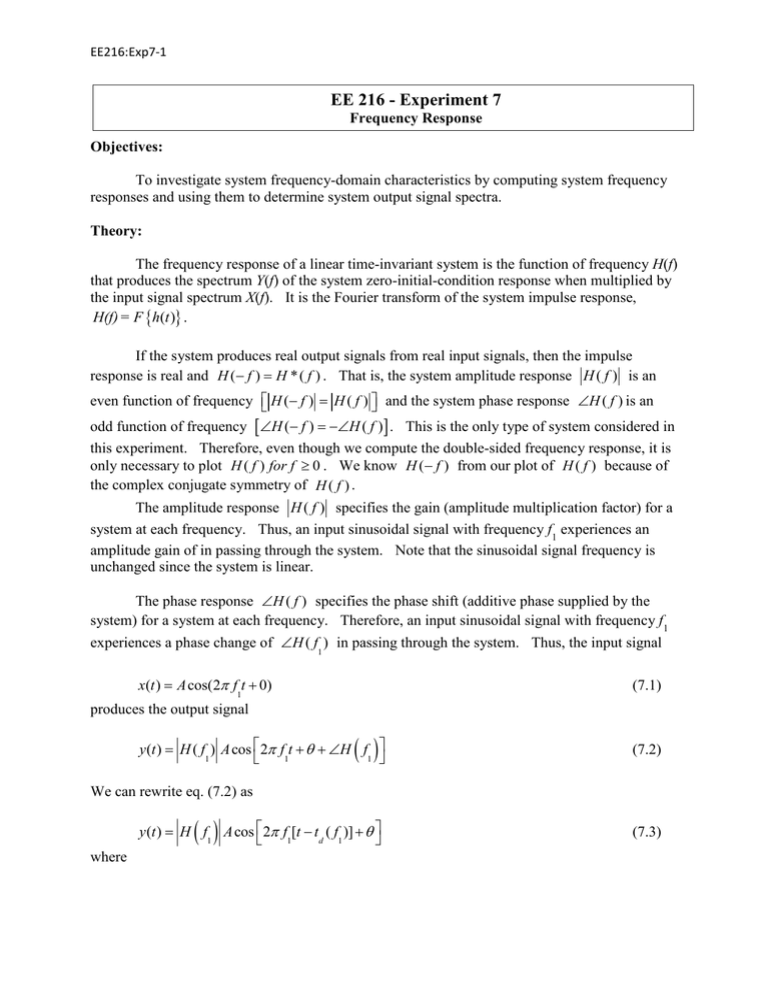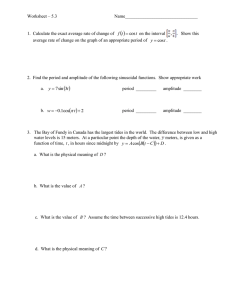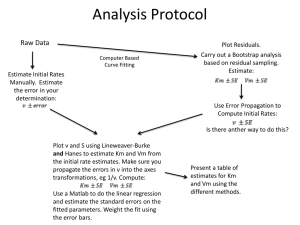7 Frequency Response
advertisement

EE216:Exp7-1
EE 216 - Experiment 7
Frequency Response
Objectives:
To investigate system frequency-domain characteristics by computing system frequency
responses and using them to determine system output signal spectra.
Theory:
The frequency response of a linear time-invariant system is the function of frequency H(f)
that produces the spectrum Y(f) of the system zero-initial-condition response when multiplied by
the input signal spectrum X(f). It is the Fourier transform of the system impulse response,
H(f)= F {h(t )} .
If the system produces real output signals from real input signals, then the impulse
response is real and H (− f ) =
H *( f ) . That is, the system amplitude response H ( f ) is an
even function of frequency H (− f =
) H ( f ) and the system phase response ∠H ( f ) is an
odd function of frequency [ ∠H (− f ) = −∠H ( f ) ] . This is the only type of system considered in
this experiment. Therefore, even though we compute the double-sided frequency response, it is
only necessary to plot H ( f ) for f ≥ 0 . We know H (− f ) from our plot of H ( f ) because of
the complex conjugate symmetry of H ( f ) .
The amplitude response H ( f ) specifies the gain (amplitude multiplication factor) for a
system at each frequency. Thus, an input sinusoidal signal with frequency f1 experiences an
amplitude gain of in passing through the system. Note that the sinusoidal signal frequency is
unchanged since the system is linear.
The phase response ∠H ( f ) specifies the phase shift (additive phase supplied by the
system) for a system at each frequency. Therefore, an input sinusoidal signal with frequency f1
experiences a phase change of ∠H ( f ) in passing through the system. Thus, the input signal
1
=
x(t ) A cos(2π f t + 0)
(7.1)
1
produces the output signal
( )
(7.2)
( ) A cos 2π f [t − t ( f )] + θ
(7.3)
=
y (t ) H ( f ) A cos 2π f t + θ + ∠H f
1
1
1
We can rewrite eq. (7.2) as
y (t ) H f
=
1
where
1
d
1
EE216:Exp7-2
t (f )= −
d
( )
∠H f
1
(7.4)
2π f
1
1
The time t
d
( f ) is the time delay of the output signal with respect to the input signal when
1
the signal frequency is f1. We call this the system time delay. Note that the system phase
response value determines the system time delay. Also a negative phase response for f > 0
implies a positive time-delay. That is the output signal is delayed in time. On the other hand, a
positive phase response for f > 0 implies a negative time delay, which is an output signal time
advance.
Consider a system for which the phase response lies on a straight line through the origin,
k
, a constant, for all
∠H ( f ) =
kf for some interval of frequencies. In this case t ( f ) = −
1
d
1
2π
signal frequencies in the frequency interval. If a signal only contains frequencies in this interval
and the system gain is constant over the interval, then the output signal is just a time-delayed
version of the input signal multiplied by the gain constant. In real amplifiers, this constant gain
and constant phase slope is not realizable exactly so some signal distortion occurs in passing
through the amplifier.
Because of linearity, if the system input is a sum of sinusoids
x(t )
=
then
the output will be x ( t )
=
∑ A cos ( H ( f ) ) cos ( 2π f t + Φ
N
i =1
1
1
1
1
∑ A cos ( 2π f t + Φ )
N
i =1
i
1
1
( )) .
+ ∠H f
1
The bandwidth of a system is defined from the system frequency response in the same way
that the bandwidth of a signal is defined from the signal spectrum. System bandwidth is
important to us since we need to know whether a given signal can be passed in its entirety by a
system. The lowest and highest positive frequencies for which H ( f ) ≥ α H ( f ) max are called
the lower and upper cutoff frequencies of the system, respectively. The system bandwidth is the
upper cutoff frequency minus the lower cutoff frequency. The interval between the two
frequencies is called the system passband.
Preliminary:
1.
Find the mathematical expression for the frequency response of the RC low pass filter
circuit shown in Figure 7.1.
EE216:Exp7-3
Laboratory Procedure:
1.
Consider the low pass RC filter shown in Figure 7.1
2kΩ
+
x(t)
+
10µF
-
y(t)
-
Figure 7.1 RC Low Pass Filter
a.
b.
c.
2.
You were given found the impulse response of this circuit in Experiment 2 Part 5,
1 − RCt
namely h(t ) =
e u ( t ) . Find and plot the amplitude response and the phase
RC
response. Use the ctft commands. Also plot the aplitude response and phase
response for the analytically plot the two amplitude responses on the same set of
axes and the two phase responses on the same set of axes, determined in the
preliminary for comparison.
−1.5cos ( 8π t ) + 0.4 cos ( 40π t ) . Find the output
Consider an input signal x ( t ) =
for each signal component and plot with the corresponding input signal component
on the same set of axes. Use convolution to find the output signals, in Matlab,
given the impulse response. Compute the gain for each signal component by
taking the ratio of the input and output signal maximum values. Compute the time
delay for each component by finding the time corresponding to the first peak of the
output after t = 0
Compute the system gain and time delay at each signal component frequency from
the amplitude and phase responses. Compare these values with the values
computed in Part b.
In Experiment 4 Part 3 we plotted the response of the system represented by the differential
equation from Part 1 of the Experiment 2 Preliminary to each component of the input signal
x (t ) =
−3.9 cos ( 0.2π t − 1.5 ) + 3.75cos ( 0.5π t − 0.6 ) + 0.5cos (1.2π t + 0.2 ) (7.5)
a.
We computed and plotted samples of the impulse response for the system in
Experiment 3, Part 4. Therefore, reuse the first part of the script that you
developed for Experiment 3, Part 4 to find samples of and plot the system impulse
response. Use a sample spacing of 0.002 s and −1 ≤ t ≤ 12 s .
b.
Use the Fourier Transform to compute and plot the system amplitude and phase
responses.
EE216:Exp7-4
c.
Compute the system gain and phase shift for each signal component. Use these
values to construct the output signal equation from the input signal equation. How
do the output signal component amplitudes compare with those found in
Experiment 4, Part 3c?
Plot each component of the input and output on one set of axes. Use a separate set
of axes for each component. Compare with the results of Experiment 4, Part 3. A
visual comparison is adequate.
d.
Add the input and output signal components and plot the input and output signals
on one set of axes like you did in Part 3b of Experiment 4. Visually compare the
output signal from here (using the system frequency response) with the output
signal found in Experiment 4, Part 3b (using the superposition integral).



![ ]. ) /](http://s2.studylib.net/store/data/015834125_1-06c22f0bdc3e34adb72b4710444befe7-300x300.png)